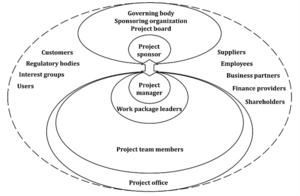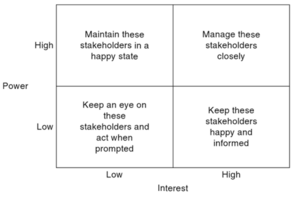Managing stakeholders
Contents |
Abstract
According to the ISO 21502 standards, a stakeholder a person, group or organization that has interest in, or can affect, be affected by, or perceive itself to be affected by, any aspect of a project, programme or portfolio [1]. Stakeholder management is the process of organizing, monitoring and improving relationships with stakeholders.
When managing stakeholders, it is necessary to identify all the stakeholders, analyze their needs and expectations, as well as planning and carrying out various tasks in order to engage with them. Effective stakeholder management necessitates not only understanding the values and issues that stakeholders must address, but also keeping all stakeholders on board and interested in the duration of the project.
A stakeholder analysis is used to identify the project's stakeholders. It is a critical step in ensuring that the project will be a success. Identifying your project's stakeholders, particularly those who will be impacted indirectly can be a challenge. The power-interest grid is a popular and tested way to get a better understanding of the interest level of stakeholders. The stakeholders are placed on the grid based on their power in the project and interest, they are then managed according to the placement. If the stakeholders have both high interest and high power, then they must be very closely managed, and more effort must be made to satisfy them. However, if the stakeholder has low power and interest, they do not need to be closely managed but should still be monitored and not over-communicated.
Big idea
Stakeholder management is extremely important since stakeholders play a major role in almost every project regardless of what type of project it is. Stakeholders are individuals or groups with a stake, which is an interest or a share in a certain project or organization. They can be affected by project or organizations activities but they can also affect their goals, development and sometimes even their survival [2]. To sum up, stakeholders have a lot of power and therefore it is crucial to manage in a way that keeps them as a benefit to a project rather than a threat. Most organizations and project cannot thrive without stakeholders since they provide a lot of information, resources and other services [2].
Stakeholder management involves identifying and classifying different stakeholders that will affect a certain project. As mentioned in the book about construction stakeholder management this engagement involves identifying different categories of stakeholders; gathering information about them; identifying their missions in a project; determining their strengths and weaknesses; identifying their strategies; predicting their behaviour and developing and implementing a strategy for managing these stakeholders [2].
In most project the stakeholders are divided into two categories to manage them more easily, these two categories are internal stakeholders and external stakeholders. The internal stakeholders are usually those who are significantly impacted by a project, like investors. The external stakeholders are usually outside a project but still get affected by it, external stakeholders are very important in the long run since they are very often the customers. Figure 1 shows possible stakeholders in different circles, the ones in the outer circle being the external stakeholders and the ones in the inner circles being the internal stakeholders.

Application
Explain this figure...

- Discuss the power-interest matrix
- Discuss further stakeholder mapping
- Engaging with stakeholders
- Salience model
- Organizational map
Limitations
- Discuss the limitations of stakeholder management
Annotated Bibliography
[1]
[2]
Annotated Figures
[Figure 1] An example of potential project stakeholders
[Figure 2]: A power-interest matrix
References
- ↑ 1.0 1.1 Danish-Standards-Association. (2020). Project, programme and portfolio management – guidance on project management. ISO 21502.
- ↑ 2.0 2.1 2.2 2.3 Chinyio, Ezekiel & Olomolaiye, Paul. (2010). Construction Stakeholder Management. Blackwell Publishing Ltd
key words-other categories